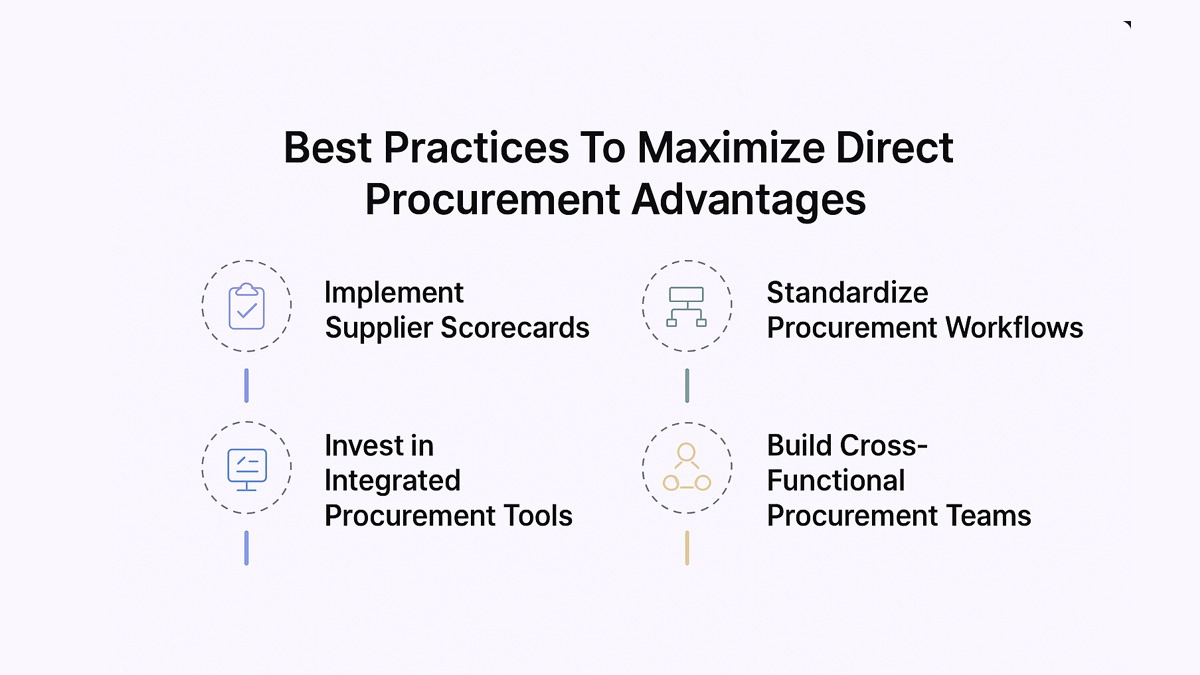

7 Hidden Advantages of Direct Procurement You Didn’t Know About

7 Hidden Advantages of Direct Procurement You Didn’t Know About
Explore 7 hidden benefits of direct procurement and how it boosts supply chain stability, cost control, and product quality.


Imagine running a factory line that depends on a steady flow of parts. One delayed shipment, and your whole operation stalls. That’s the power - and the risk - tied to your procurement process. Direct procurement, when done right, becomes your silent engine, fueling quality, speed, and cost efficiency. It’s not just about buying materials. It’s about building resilience.
What this blog will cover:
- What is direct procurement?
- Why is direct procurement important
- Challenges of direct procurement
- Best practices to maximize direct procurement advantages
- How Spendflo helps with direct procurement efficiency
- Frequently asked questions on advantages of direct procurement
What Is Direct Procurement?
Direct procurement refers to the sourcing of raw materials, components, and goods that are directly tied to a company’s production or core service delivery. Unlike indirect procurement - which includes office supplies or marketing services - direct procurement impacts your end product and customer experience.
7 Powerful Ways Direct Procurement Gives You an Edge
Direct procurement isn’t just a cost center. Done strategically, it’s a growth enabler - powering your supply chain, enhancing quality, and improving the speed at which your products reach customers. Below are seven compelling advantages that make it a game-changer for procurement and finance teams.
1. Ensures Supply Chain Stability
Direct procurement creates tighter control over supply chain operations. Strong supply chain management ensures these procurement efforts align seamlessly with broader operational goals. By working directly with suppliers for critical components, companies reduce dependency on intermediaries and improve visibility. This results in fewer disruptions, better demand planning, and more reliable production cycles. Especially in volatile markets, this kind of predictability is invaluable. It also acts as a buffer against unexpected supply chain disruptions.
2. Improves Product Quality
When you’re sourcing core materials directly, you gain the ability to enforce specific quality standards. You’re not relying on someone else’s judgment - you set the benchmarks. This direct line to the supplier allows for ongoing collaboration, faster feedback loops, and fewer quality-related surprises. Over time, that consistency becomes a competitive advantage.
3. Strengthens Supplier Relationships
There’s something powerful about a long-term, mutually beneficial supplier partnership. Direct procurement fosters collaboration - not just transactions. Strong relationships often translate to better pricing, priority support during shortages, early access to innovations, and shared risk during disruptions. It’s not just business. Effective vendor management plays a crucial role in achieving these outcomes. It’s a strategic alliance.
4. Enables Strategic Sourcing
With greater involvement in supplier selection and contract negotiation, direct procurement puts you in the driver’s seat. You can assess vendors for cost-effectiveness, innovation capability, sustainability alignment, and more. Using a formal Request for Proposal process at this stage can bring structure and transparency to vendor selection. It’s not about picking the cheapest option - it’s about picking the right one. This shifts procurement from operational to strategic.
5. Provides Better Cost Control
No middlemen means fewer markups. This directly translates to lower procurement costs and leaner purchasing cycles. Direct procurement opens the door to transparent pricing structures and lets you negotiate directly with suppliers. This direct negotiation allows businesses to benchmark against real-time market pricing for better deal-making. It also reduces the risks of duplication and wastage. For finance teams under pressure to stretch every dollar, this kind of control is gold. Improved cost control in procurement can also lead to healthier cash flow across departments.
6. Enhances Forecasting Accuracy
Because direct procurement is tightly tied to production planning, it offers a clearer picture of upcoming needs. Accurate alignment with production needs ensures smoother inventory cycles and fewer emergency purchases. With direct access to supplier schedules, inventory levels, and lead times, companies can forecast with greater accuracy. Strong inventory management practices make this forecasting even more reliable and efficient. That means fewer last-minute rush orders - and fewer budget surprises.
7. Supports Faster Time-To-Market
In fast-moving industries, time is a competitive weapon. Direct procurement eliminates unnecessary steps in the sourcing process, speeding up production and delivery cycles. Whether you’re launching a new product or scaling an existing one, shaving off weeks (or even days) can make a massive difference.
Challenges of Direct Procurement
While direct procurement brings undeniable advantages, it isn’t without its own set of complexities. The very things that make it powerful - deeper supplier involvement, impact on production, strategic sourcing - also introduce potential friction points. Here are some of the most common challenges companies face when managing direct procurement:

1. Dependency on Key Suppliers
Relying heavily on a limited set of suppliers can create bottlenecks. If a vendor misses a delivery or suffers a disruption, your production line feels it immediately. Unlike indirect procurement, there’s often no easy backup or workaround when the raw materials or components are critical to your output.
2. Complex Supplier Onboarding
Direct procurement requires rigorous onboarding to ensure supplier capabilities align with your product specs, compliance needs, and operational timelines. It’s not just about paperwork. It’s about aligning systems, expectations, and sometimes even cultures - which can be time-intensive and resource-heavy.
3. Greater Operational Oversight
Managing direct procurement means juggling multiple moving parts: forecasting demand, managing inventory, aligning production timelines, and monitoring supplier performance. All of this requires tight internal coordination between finance, procurement, and operations teams. A unified approach to procurement management reduces miscommunication and siloed decisions. One misstep can cause a ripple effect downstream.
4. Quality Risk Management
When raw materials are subpar, the final product suffers - and your brand reputation may take a hit. With direct procurement, you’re often first in line to deal with quality issues. Having the right checks and controls in place becomes essential to avoid production delays or costly recalls. Consistent quality control is non-negotiable in direct procurement where component integrity directly impacts product outcomes.
Best Practices To Maximize Direct Procurement Advantages
To fully unlock the benefits of direct procurement, companies need more than a good strategy - they need consistent execution. The right mix of tools, processes, and cross-functional alignment can make all the difference. Here’s how leading companies maximize their ROI from direct procurement:

Implement Supplier Scorecards
Track supplier performance across key metrics like quality, delivery timelines, pricing accuracy, and responsiveness. A dedicated category manager can use this data to identify supplier improvement areas or renegotiation opportunities. A standardized scorecard helps you hold vendors accountable, spot trends early, and guide better sourcing decisions over time.
Standardize Procurement Workflows
Establish repeatable, scalable procurement workflows for requisitioning, approvals, purchase orders, and payment. These workflows help standardize the procurement lifecycle from request to delivery. This reduces errors, improves efficiency, and ensures compliance - especially important when managing a large volume of high-impact purchases.
Invest in Integrated Procurement Tools
Using siloed systems to manage direct procurement can lead to data gaps and miscommunication. Tools that connect sourcing, inventory, and finance functions give everyone the same view of the process - enabling faster decisions and better forecasting. When enhanced with AI-driven analytics, these tools can surface insights that reduce cost and improve supplier performance.
Build Cross-Functional Procurement Teams
Direct procurement doesn’t belong to just one department. Aligning procurement, finance, production, and quality teams ensures that sourcing decisions support broader business goals. This alignment also simplifies change management during supplier transitions or new process rollouts. It also builds stronger supplier relationships through more consistent communication and follow-through.
How Spendflo Helps With Direct Procurement Efficiency
Spendflo simplifies the chaos of direct procurement by giving you a single platform to manage vendors, contracts, and renewals - all in one place. Centralized contract management further streamlines renewals, compliance, and supplier obligations. With real-time visibility into your software stack and supplier agreements, you gain tighter control over your spend, timelines, and vendor performance. Our negotiation experts also help secure better terms, reduce costs, and eliminate procurement inefficiencies - so you can focus on what matters: delivering great products, faster.
Frequently Asked Questions on Advantages of Direct Procurement
What is the difference between direct and indirect procurement?
Direct procurement involves sourcing materials and goods that directly affect your company’s product or service - like raw materials or parts. Indirect procurement covers items that support the business but don’t directly go into the product, such as office supplies or marketing tools.
How does direct procurement impact production timelines?
Since direct procurement deals with essential materials, any delay in sourcing or delivery can disrupt production. Efficient direct procurement ensures that materials arrive on time, keeping manufacturing schedules on track and reducing downtime.
What tools can help streamline direct procurement?
Integrated procurement software like Spendflo, ERP systems, and supplier portals can automate workflows, track vendor performance, and provide real-time visibility into spend and supply chain status - helping reduce errors and speed up procurement cycles.
Why do companies prefer direct procurement for core operations?
Direct procurement allows businesses to have more control over quality, pricing, and delivery timelines. It supports strategic vendor relationships, helps maintain consistent production, and often leads to better cost management and competitive advantage.
What role does a procurement strategy play in direct procurement?
A solid procurement strategy helps align sourcing efforts with business goals. It ensures better supplier selection, cost efficiency, and long-term planning, especially when managing high-impact direct purchases.
How can supplier management impact cost reduction?
Effective supplier management allows businesses to optimize pricing, reduce errors, and negotiate better terms. This directly contributes to cost reduction and improved operational efficiency.
What negotiation skills are essential for successful direct procurement?
Skills like price benchmarking, understanding contract terms, and managing supplier relationships are key. Strong negotiation ensures better deals, supports a healthy category strategy, and leads to sustainable procurement outcomes.










.png)




.png)










.avif)





